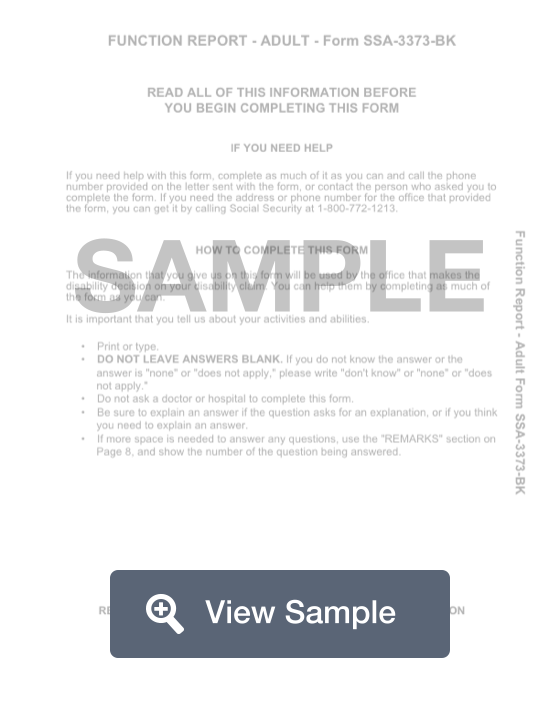What is a SSA 3373 BK?
A Form SSA 3373-BK is known as an Adult Function Report. This form will be used by the Social Security Administration to determine whether or not someone is eligible for social security benefits such as disability or SSI. This is a lengthy form that is required in order for the SSA to examine how well an individual can function during the various aspects of their life. This will include functioning physically and mentally.
This form should be filled out with as much detail as possible. This will allow the Social Security Administration to determine whether or not you can work at a job with your current limitations. You may also need to fill out a separate form to detail your current pain or fatigue levels. Like with other disability forms, you can include medical documentation to back up your claims.
How to complete an SSA 3373 BK (Step by Step)
To complete a SSA-3373-BK, you will have to provide the following information:
- Section A - General Information
- Name of the disabled person
- Social security number
- Your daytime telephone number
- Where you live
- With whom you live
- Section B - Information About Your Illnesses, Injuries, or Conditions
- Explain how your illnesses, injuries, or conditions limit your ability to work
- Section C - Information About Daily Activities
- Describe your daily routine
- Explain whether you provide care for anyone else
- Explain whether you care for pets or animals
- Explain whether anyone helps you to care for other people or animals
- Explain what you were able to do before your illnesses, injuries, or conditions that you can’t do now
- Explain whether your illnesses, injuries, or conditions affect your sleep
- Personal care
- Explain how your condition affects your ability to: dress, bathe, care for hair, shave, feed self, use the toilet, other
- Explain any reminders you need to take care of your personal needs and grooming
- Explain any help or reminders you need to take medicine
- Meals
- Explain whether you prepare your own meals, what kinds of food you prepare, how often you prepare it, how long it takes you, any changes in cooking habits since the condition began, or why you cannot or do not prepare meals
- House and yard work
- List the chores that you are able to do, how long they take you to do, how often you do them, whether you need help doing them, or why you don’t do house or yard work
- Getting around
- Describe how often you go outside or why you do not go out
- Describe your form of transportation
- Whether you can go out alone or explanation why not
- Whether you can drive or explanation why not
- Shopping
- Whether you shop in stores, on the phone, by mail, or by computer
- Describe what you shop for and how long it takes
- Money
- Whether you are able to: pay bills, count change, handle a savings account, use a checkbook/money orders or explanation why not
- Whether your ability to handle money has changed since your condition began and explanation how
- Hobbies and interests
- Describe hobbies and interests
- Describe how often and well you do these things
- Describe any changes in activities since the illnesses, injuries, or conditions began
- Social activities
- Indicate whether you spend time with others and explain the types of things you do with them and how often you do them
- List the places you go on a regular basis
- Explain whether you need to be reminded to go to places
- Explain how often you go and how much you take part
- Explain whether you need someone to accompany you
- Explain any problems you have getting along with family, friends, neighbors, or others
- Describe any changes in social activities since your condition began
- Section D - Information About Abilities
- Indicate any of the items that your conditions affect: lifting, squatting, bending, standing, reaching, walking, sitting, kneeling, talking, hearing, stair climbing, seeing, memory, completing tasks, concentration, understanding, following instructions, using hands, getting along with others
- Explain how your condition affects those activities
- Indicate your dominant hand
- Indicate how far you can walk before needing to stop and rest and, if you have to rest, how long before you can resume walking
- Indicate how long you can pay attention
- Indicate whether you finish what you start
- Indicate how well you follow written directions
- Indicate how well you follow spoken instructions
- Indicate how well you get along with authority figures
- Indicate whether you have ever been fired or laid off from a job because of problems getting along with people
- Indicate how well you handle stress
- Indicate how well you handle changes in routine
- Indicate whether you’ve noticed any unusual behavior or fears
- Indicate whether you use any of the following: crutches, walker, wheelchair, cane, brace/splint, artificial limb, hearing aid, glasses/contact lenses, artificial voice box
- Indicate any of the items that were prescribed, when they were prescribed, and why you need them
- Explain any medicines that you take for illnesses, injuries, or conditions and any side effects that they cause
- Section E - Remarks
- Explain any information that you did not show in earlier parts of the form
- Name of person completing form
- Date
- Address


